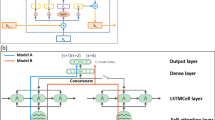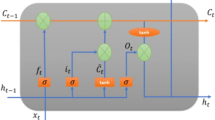Abstract
Arguably, El Niño-Southern Oscillation (ENSO) is the most influential climatological phenomenon that has been intensively researched during the past years. Currently, the scientific community knows much about the underlying processes of ENSO phenomenon, however, its predictability for longer horizons, which is very important for human society and the natural environment is still a challenge in the scientific community. Here we show an approach based on using various complex networks metrics extracted from climate networks with long short-term memory neural network to forecast ENSO phenomenon. The results suggest that the 12-network metrics extracted as predictors have predictive power and the potential for forecasting ENSO phenomenon longer multiple steps ahead.




Similar content being viewed by others
Explore related subjects
Discover the latest articles, news and stories from top researchers in related subjects.References
World Meteorological Organization (2014) El Niño-Southern Oscillation. WMO-No. 1145, ISBN: 978-92-63-11145-6
Barnston AG, Tippett MK, L’Heureux ML, Li S, DeWitt DG (2012) Skill of real-time seasonal ENSO model predictions during 2002–2011: is our capability increasing? Bull Am Meteorol Soc 93(5):631–651
Ludescher J, Gozolchiani A, Bogachev MI, Bunde A, Havlin S, Schellnhuber HJ (2014) Very early warning of next El Niño. Proc Natl Acad Sci USA 111(6):2064–2066
Ben Taieb S, Bontempi G, Atiya AF, Sorjamaa A (2012) A review and comparison of strategies for multi-step ahead time series forecasting based on the NN5 forecasting competition. Expert Syst Appl 39(8):7067–7083
Zebiak SE, Cane MA (1987) A model El Niñ-Southern Oscillation. Mon Weather Rev 115:2262–2278
Gers FA, Schmidhuber J, Cummins F (2000) Learning to forget: continual prediction with LSTM. Neural Comput 12(10):2451–2471
Akram Zaytar M, El Amrani C (2016) Sequence to sequence weather forecasting with long short-term memory recurrent neural networks. IJCA 143(11):7–11
Zhang Q, Wang H, Dong J, Zhong G, Sun X (2017) Prediction of sea surface temperature using long short-term memory. IEEE Geosci Remote Sens Lett 14(10):1745–1749
Lipton ZC, Berkowitz J, Elkan C (2015), A critical review of recurrent neural networks for sequence learning. arXiv:1506.00019v4
Li Y, Yang R, Yang C, Yu M, Hu F, Jiang Y (2017) Leveraging LSTM for rapid intensifications prediction of tropical cyclones. ISPRS Ann Photogramm Remote Sens Spatial Inf Sci IV-4/W2:101–105
Hong C, Cho K-D, Kim H-J (2001) The relationship between ENSO events and sea surface temperature in the East (Japan) Sea. Prog Oceanogr 49(1–4):21–40
Catto JL, Nicholls N, Jakob C (2012) North Australian sea surface temperatures and the El Niño–Southern Oscillation in observations and models. J Clim 25(14):5011–5029
Tsonis AA, Roebber PJ (2004) The architecture of the climate network. Phys A 333:497–504
Albert R, Barabási A-L (2002) Statistical mechanics of complex networks. Rev Mod Phys 74(1):47–97
Steinhaeuser K, Chawla NV, Ganguly AR (2010) Complex networks in climate science: progress, opportunities and challenges. In: Proceedings of the 2010 conference on intelligent data understanding, USA, pp 16–26
Donner RV, Wiedermann M, Donges JF (2017) Complex network techniques for climatological data analysis. In: Franzke CLE, O’Kane TJ (eds) Nonlinear and stochastic climate dynamics. Cambridge University Press, Cambridge, pp 159–183
Zanin M, Papo D, Sousa PA, Menasalvas E, Nicchi A, Kubik E, Boccaletti S (2016) Combining complex networks and data mining: why and how. Phys Rep 635:1–44
Steinhaeuser K, Chawla NV, Ganguly AR (2011) Complex networks as a unified framework for descriptive analysis and predictive modeling in climate science. Stat Anal Data Min 4(5):497–511
Saha M, Mitra P (2015) Climate network based index discovery for prediction of Indian monsoon. In: Kryszkiewicz M, Bandyopadhyay S, Rybinski H, Pal SK (eds) Pattern recognition and machine intelligence 9124. Springer International Publishing, Cham, pp 554–564
Sencan H, Chen Z, Hendrix W, Pansombut T, Semazzi F, Choudhary A, Kumar V, Melechko AV, Samatova NF (2011), Classification of emerging extreme event tracks in multivariate spatio-temporal physical systems using dynamic network structures: application to hurricane track prediction. In: IJCAI’11 proceedings of the twenty-second international joint conference on artificial intelligence, Barcelona, Spain, vol 2, pp 1478–1484
van der Linden JH, Narsilio GA, Tordesillas A (2016) Machine learning framework for analysis of transport through complex networks in porous, granular media: a focus on permeability. Phys Rev E 94(2–1):022904
Jamal W, Das S, Oprescu I-A, Maharatna K, Apicella F, Sicca F (2014) Classification of autism spectrum disorder using supervised learning of brain connectivity measures extracted from synchrostates. J Neural Eng 11(4):046019
Dijkstra HA (2006) The ENSO phenomenon: theory and mechanisms. Adv Geosci 6:3–15
Landsea CW, Knaff JA (2000) How much skill was there in forecasting the very strong 1997–1998 El Niño? Bull Am Meteorol Soc 81:2107–2119
Kalnay E, Kanamitsu M, Kistler R, Collins W, Deaven D, Gandin L, Iredell M, Saha S, White G, Woollen J, Zhu Y, Leetmaa A, Reynolds B, Chelliah M, Ebisuzaki W, Higgins W, Janowiak J, Mo KC, Ropelewski C, Wang J, Roy J, Dennis J (1996) The NCEP/NCAR 40-year reanalysis project. Bull Am Meteorol Soc 77:437–472
Huang B, Thorne PW, Banzon VF, Boyer T, Chepurin G, Lawrimore JH, Menne MJ, Smith TM, Vose RS, Zhang H-M (2017) Extended reconstructed sea surface temperature, version 5: upgrades, validations, and intercomparisons. J Clim 30(20):8179–8205
Radebach A, Donner RV, Runge J, Donges JF, Kurths J (2013) Disentangling different types of El Niño episodes by evolving climate network analysis. Phys Rev E Stat Nonlin Soft Matter Phys 88(5):052807
Hochreiter S, Schmidhuber J (1997) Long short-term memory. Neural Comput 9(8):1735–1780
Gers FA, Eck D, Schmidhuber J (2002) Applying LSTM to time series predictable through time-window approaches. In: Tagliaferri R, Marinaro M (eds) Neural nets WIRN Vietri-01. Springer, London, London, pp 193–200
Sutskever I, Vinyals O, Le QV (2014) Sequence to sequence learning with neural networks. arXiv:1409.3215
Donges JF, Zou Y, Marwan N, Kurths J (2009) Complex networks in climate dynamics: comparing linear and nonlinear network construction methods. Eur Phys J Spec Topics 174(1):157–179
Donges JF, Heitzig J, Beronov B, Wiedermann M, Runge J, Feng QY, Tupikina L, Stolbova V, Donner RV, Marwan N, Dijkstra HA, Kurths J (2015) Unified functional network and nonlinear time series analysis for complex systems science: the pyunicorn package. Chaos 25(11):113101
LdaF Costa, Rodrigues FA, Travieso G, Villas Boas PR (2007) Characterization of complex networks: a survey of measurements. Adv Phys 56(1):167–242
Barnston A (2014) How good have ENSO forecasts been lately?. National Oceanic and Atmospheric Administration (NOAA). https://www.climate.gov/news-features/blogs/enso/how-good-have-enso-forecasts-been-lately. Accessed 20 Mar 2017
Author information
Authors and Affiliations
Corresponding author
Additional information
Publisher's Note
Springer Nature remains neutral with regard to jurisdictional claims in published maps and institutional affiliations.
About this article
Cite this article
Broni-Bedaiko, C., Katsriku, F.A., Unemi, T. et al. El Niño-Southern Oscillation forecasting using complex networks analysis of LSTM neural networks. Artif Life Robotics 24, 445–451 (2019). https://doi.org/10.1007/s10015-019-00540-2
Received:
Accepted:
Published:
Issue Date:
DOI: https://doi.org/10.1007/s10015-019-00540-2




